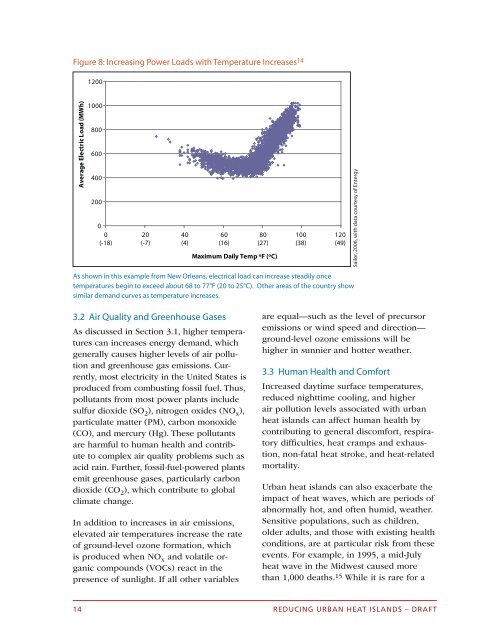Urban Heat Island Basics - US Environmental Protection Agency
Urban Heat Island Basics - US Environmental Protection Agency
Urban Heat Island Basics - US Environmental Protection Agency
You also want an ePaper? Increase the reach of your titles
YUMPU automatically turns print PDFs into web optimized ePapers that Google loves.
Figure 8: Increasing Power Loads with Temperature Increases 14<br />
Average Electric Load (MWh)<br />
1200<br />
1000<br />
800<br />
600<br />
400<br />
200<br />
0<br />
0<br />
(-18)<br />
20<br />
(-7)<br />
40<br />
(4)<br />
60<br />
(16)<br />
3.2 Air Quality and Greenhouse Gases<br />
As discussed in Section 3.1, higher temperatures<br />
can increases energy demand, which<br />
generally causes higher levels of air pollution<br />
and greenhouse gas emissions. Currently,<br />
most electricity in the United States is<br />
produced from combusting fossil fuel. Thus,<br />
pollutants from most power plants include<br />
sulfur dioxide (SO 2), nitrogen oxides (NO x),<br />
particulate matter (PM), carbon monoxide<br />
(CO), and mercury (Hg). These pollutants<br />
are harmful to human health and contribute<br />
to complex air quality problems such as<br />
acid rain. Further, fossil-fuel-powered plants<br />
emit greenhouse gases, particularly carbon<br />
dioxide (CO 2 ), which contribute to global<br />
climate change.<br />
In addition to increases in air emissions,<br />
elevated air temperatures increase the rate<br />
of ground-level ozone formation, which<br />
is produced when NO x and volatile organic<br />
compounds (VOCs) react in the<br />
presence of sunlight. If all other variables<br />
are equal—such as the level of precursor<br />
emissions or wind speed and direction—<br />
ground-level ozone emissions will be<br />
higher in sunnier and hotter weather.<br />
3.3 Human Health and Comfort<br />
Increased daytime surface temperatures,<br />
reduced nighttime cooling, and higher<br />
air pollution levels associated with urban<br />
heat islands can affect human health by<br />
contributing to general discomfort, respiratory<br />
difficulties, heat cramps and exhaustion,<br />
non-fatal heat stroke, and heat-related<br />
mortality.<br />
<strong>Urban</strong> heat islands can also exacerbate the<br />
impact of heat waves, which are periods of<br />
abnormally hot, and often humid, weather.<br />
Sensitive populations, such as children,<br />
older adults, and those with existing health<br />
conditions, are at particular risk from these<br />
events. For example, in 1995, a mid-July<br />
heat wave in the Midwest caused more<br />
than 1,000 deaths. 15 While it is rare for a<br />
14 RedUcING URBAN HeAt IslANds – dRAFt<br />
80<br />
(27)<br />
Maximum Daily Temp ºF (ºC)<br />
As shown in this example from New Orleans, electrical load can increase steadily once<br />
temperatures begin to exceed about 68 to 77°F (20 to 25°C). Other areas of the country show<br />
similar demand curves as temperature increases.<br />
100<br />
(38)<br />
120<br />
(49)<br />
Sailor, 2006, with data courtesy of Entergy

















